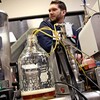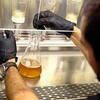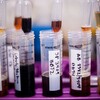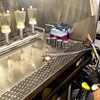This image shows how we extract iso-alpha acids from beer in order to find out how many IBUs are present. We acidify the beer sample in order to make the iso-alpha acids (IAAs) less soluble in beer and more soluble in the non-miscible iso-octane. The iso-octane will extract the IAAs and we will use our UV-Vis spectrophotometer to measure the absorbency at 240 nm in order to find out how many IBUs…
We took a random bottle off of the packaging line to analyze it for the concentration of dissolved oxygen present in the beer. We punch a hole in the cap and pressurize the bottle using nitrogen - and we push the beer through a special device that detects to the part-per-billion level of oxygen in solution. Oxygen damages beer flavor over time, so we want to have the lowest possible…
This is a Gas Chromatograph (GC for short). It separates volatile compounds and measures the concentration of those compounds using various detectors. Brewing scientists can use a GC to find the amount of various off-flavors present in beer.
One off-flavor that is looked at the most is 2,3 butanedione – more commonly known as diacetyl. Diacetyl is a vicinal diketone…
For the next part of our guide to off-flavors we'll take a look at acetaldehyde, with persistance and consistency you can avoid this undesireable quality.
Acetaldehyde smells and tastes like green apples. Sometimes it’s described as “oxidized apples” or “acetic cider”.
How does it form in beer?
Acetaldehyde is the immediate precursor to ethanol in fermentation…
Continuing our discussion of off-flavors, we'll take look at diacetyl it's great on microwave popcorn, but as all brewers know, this "buttery" off-flavor has no place in beer.
Diacetyl (2,3-butanedione) is well known as the “butter” compound in microwave popcorn. It presents itself as a buttery or butterscotch flavor in beer. It’s in the vicinal diketone (VDK) category of…
A problem that all brewers face is managing and eliminating off-flavors. For the first post of this series, we'll take a look at DMS.
What is it?
DMS (dimethyl sulfide) exhibits itself as a canned vegetable or creamed corn flavor in beer.
How does it form in beer?
All malt contains a variant of the amino acid methionine called S-methyl methionine (…
Continuing our series on off-flavors we're going to look at what happens and how to deal with beer-spoiling bacteria and wild yeast infect your brew.
What is it?
Infection occurs when beer-spoiling bacteria or wild yeast make it into beer and start competing with cultured yeast for sugars. The typical off-flavors to look out for are sour and/or diacetyl (buttery). Other…
Isoamyl acetate is the ester responsible for the banana-flavor. Typically described as the “circus peanuts” flavor or the dominate flavor in german-style hefeweizens.
How does it form in beer?
This compound forms by the condensation of acetyl CoA and isoamyl alcohol during fermentation. Most esters form in beer due to the reduction of a carboxylic acid and ethanol. This…
The papery off-flavor occurs when beer is oxidized. It can also present itself as a cardboard flavor or even as a sweet stone fruit flavor.
How does it form in beer?
The major compound that causes the oxidized flavor is trans-2-nonenal (pictured above). This flavor is typically formed in packaging when stored at elevated temperatures (above 40 F) for any period of time due to…
This is a High-Performance Liquid Chromatograph (HPLC). This awesome piece of analytical equipment can measure the concentration of different compounds present in beer, wort, and hops. We use it to measure the concentration of humulone, cohumulone, lupulone, and colupulone in hops. These are collectively known as alpha and beta acids in brewing terms. The alpha acids (…









